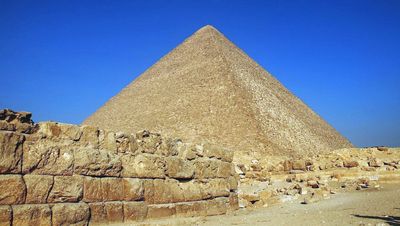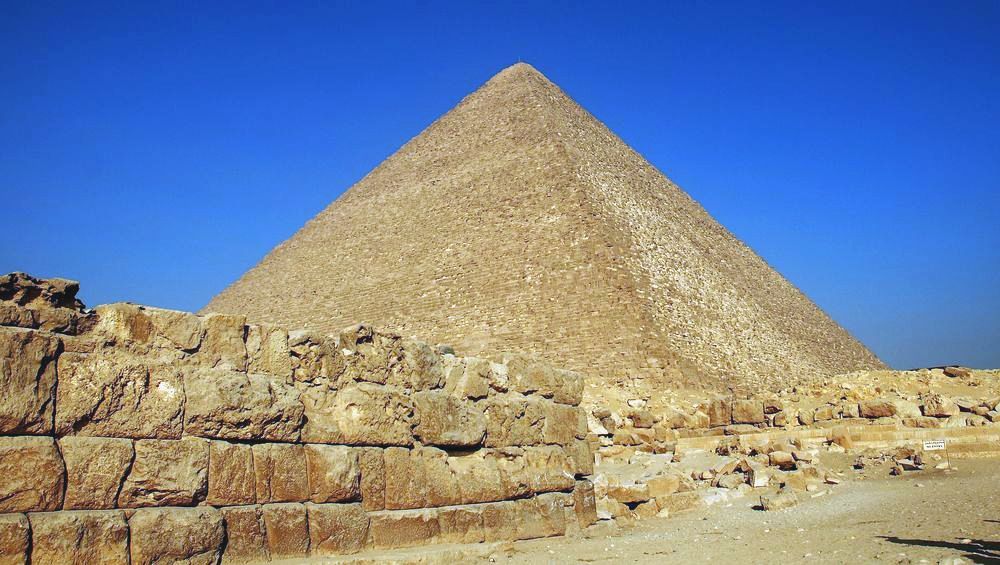The pyramid of Kheops is the first of the seven wonders of the world and the only one of its wonders still standing today. It is an imposing monument built by the Egyptians at the time of antiquity. On a square base, it was about 150m high for a 230m side. Nowadays it is a little smaller due to its erosion. It is from almost safe source the tomb of the Pharaoh Kheops who lived under the Fourth Dynasty, almost 4,500 years ago. This pyramid is the largest of all the pyramids ever built on Earth, regardless of civilization and time, so it is a curiosity that raises questions about its architecture, its methods of construction, and reasons for its construction. It is the main tomb of the necropolis of which it forms part, on the plateau of Giza, near the capital of Egypt, Cairo.

Pyramid of Cheops
Location
The first of the seven wonders of the world is Egyptian, it is located in the south-west of Cairo, the capital of Egypt. Formerly several kilometers from the city, it is nowadays bordered by the galloping urbanization of the megalopolis. More precisely, the Pyramid of Kheops is one of the pyramids of the Giza necropolis. Gizeh is a locality, a site that designates a particular rocky plateau on which was built during the IVth Dynasty a large-scale necropolis made up of several cemeteries, rock tombs, temples, a village of builders, and the Sphinx, a well-known monumental statue systematically associated with this necropolis.
Learn more about the location of the pyramid.
Description
The description of the great pyramid of Cheops is relatively simple to make. It is a pyramid of square base, of symmetrical elevation, with 4 faces. What is important about this monument is the dimensions of the building, very important, but otherwise it is more of a classical form and there is nothing special to say about its form.
On the other hand, to be more precise, one can indicate that its vertex is truncated, which was not the case initially. It is the wear and tear of time that wants this. The summit was formerly surmounted by a pyramidion that disappeared. To know what it was just look at the site, there is one, coming from another pyramid. In fact, it's just the end of the pyramid, so ... it's another pyramid, smaller. The monument was made of limestone blocks, so it is staggered, ie each block is slightly set back from that of the previous row. These blocks are of different sizes and shapes, but there is no logic in their jobs, ie one would think that the biggest ones are downstairs and the smaller ones at the top, but this is not the case. The truth and that indeed the size of the blocks decreases in ascending, but it becomes more important after a certain level and begins to decrease again. This pattern is reproduced 18 times over the entire height of the pyramid.
Dimensions
The Pyramid of Kheops remained for many centuries the highest human edifice of the World, the largest also. It measures 440 cubits to the side, ie 230.5m, which makes a footprint of 5.29 hectares. The sides are not all at the same length, there is a gap of a few centimeters. At present it measures 138m high but it was 146,60m at the origin. In unit of the time, the cubit, it measured 440 cubits of side by 280 of high.
Regarding the volume of the pyramid, it was initially 2,592 350m3 and its surface area of 53,055 m2. These two figures have decreased as a result of the erosion of the summit, which has nevertheless decreased by 9.58m.
Learn more about the dimensions of the pyramid.
Origin of materials
The pyramid uses 3 different materials: two limestones and a granite, so everything is made of stone, there is no wooden part or whatever else. The building blocks are limestone and come from a local quarry, right next to the site for obvious transportation reasons. The stones used for the cladding came from a quarry in Tourah, a city near Cairo with a finer, more brilliant limestone on its territory. Finally the base of the pyramid is in pink granite of Aswan as well as the blocks of internal masonry that forms the funerary chambers and the large interior gallery.
The phenomenon of apothema
The pyramid has four sides that look perfectly straight, but in reality each side is very slightly curved, they follow an edge that divide them into two equal parts, from top to bottom. The pyramid of Kheops has eight sides, not four, but this peculiarity, which is very little marked, is visible only at the equinoxes, on the days when the solar rays shave both sides North and South. At this moment we see that these two faces are bicolour: One half is in the shade, the other in the sun.
See also:



















